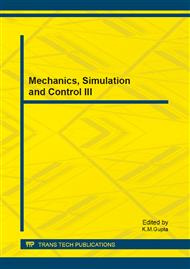p.264
p.270
p.275
p.280
p.286
p.292
p.297
p.302
p.308
Self-Adaptation of Natural-Coordinate System
Abstract:
A self-adaptation method for natural-coordinate systems is proposed, in order to automate the selection of natural coordinates for each rigid element of a multibody system. The four-step method includes: First, find out all empty positions, which come from the feature points or vectors of the joints attached to the element, and give equal weight to them; second, delete redundant empty positions and add their weight to the unique one; third, select at most four empty positions which have a maximum total weight and can be occupied by a natural-coordinate system at the same time; fourth, the standard natural-coordinate system on the element can adapt itself to the selected empty positions, leading to an actual natural-coordinate system, which contains twelve rational natural coordinates for the element. The implementation of the method has been achieved on a multibody dynamics and motion analysis platform, InteDyna, with the result that modeling efficiency is enhanced and model quality improved.
Info:
Periodical:
Pages:
286-291
Citation:
Online since:
August 2013
Authors:
Price:
Сopyright:
© 2013 Trans Tech Publications Ltd. All Rights Reserved
Share:
Citation:


